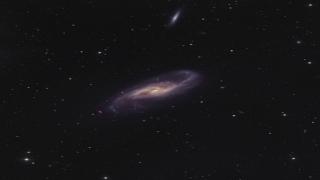Bibcode
Mok, Angus; Wilson, C. D.; Knapen, J. H.; Sánchez-Gallego, J. R.; Brinks, E.; Rosolowsky, E.
Bibliographical reference
Monthly Notices of the Royal Astronomical Society, Volume 467, Issue 4, p.4282-4292
Advertised on:
6
2017
Citations
27
Refereed citations
26
Description
We present an analysis of the radial profiles of a sample of 43 H i-flux
selected spiral galaxies from the Nearby Galaxies Legacy Survey (NGLS)
with resolved James Clerk Maxwell Telescope (JCMT) CO J = 3 - 2 and/or
Very Large Array (VLA) H I maps. Comparing the Virgo and non-Virgo
populations, we confirm that the H I discs are truncated in the Virgo
sample, even for these relatively H i-rich galaxies. On the other hand,
the H2 distribution is enhanced for the Virgo galaxies near
their centres, resulting in higher H2 to H I ratios and
steeper H2 and total gas radial profiles. This is likely due
to the effects of moderate ram pressure stripping in the cluster
environment, which would preferentially remove low-density gas in the
outskirts while enhancing higher density gas near the centre. Combined
with Hα star formation rate data, we find that the star formation
efficiency (SFR/H2) is relatively constant with radius for
both samples, but the Virgo galaxies have an ˜40 per cent lower star
formation efficiency than the non-Virgo galaxies.
Related projects

Spiral Galaxies: Evolution and Consequences
Our small group is well known and respected internationally for our innovative and important work on various aspects of the structure and evolution of nearby spiral galaxies. We primarily use observations at various wavelengths, exploiting synergies that allow us to answer the most pertinent questions relating to what the main properties of
Johan Hendrik
Knapen Koelstra